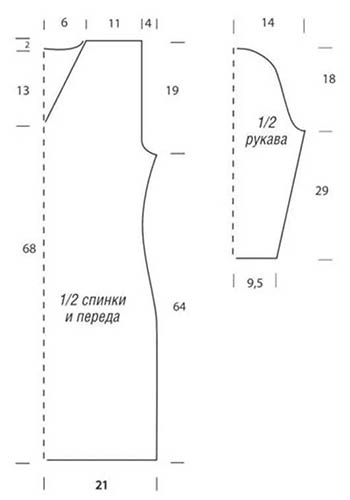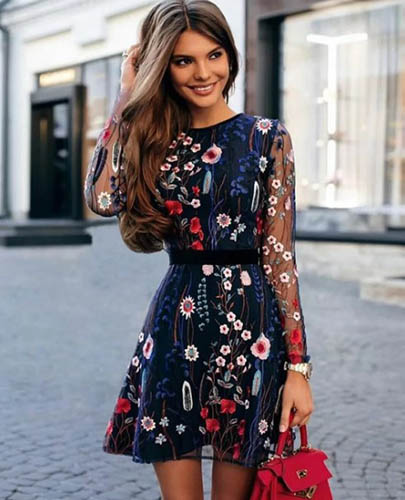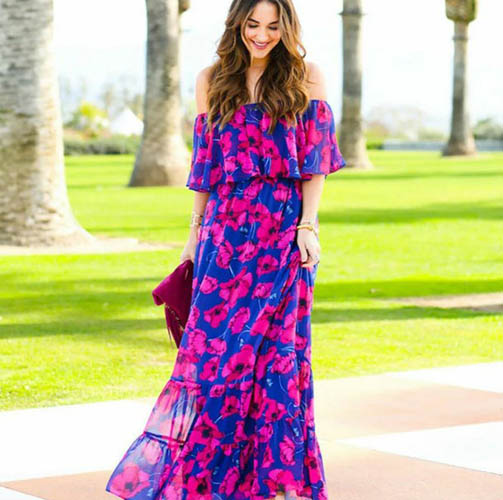Chiffon is a natural, airy, translucent fabric with a sandy texture, used for sewing casual, evening or business dresses. Made in the boho style, such models can have either long or short sleeves, are complemented by a belt and are made using fairly simple patterns that do not require clothing modeling skills.
Manufacturing Features
A boho dress with long sleeves is made of natural or synthetic chiffon.

The versatile material can be used to create office, evening or casual outfits:
- Thick chiffon is used for sewing business, evening or wedding clothes.
- Airy – for summer, beach dresses.
Chiffon, produced by weaving tightly twisted threads, has no shine and a rough, grainy surface.
Working with chiffon requires special sewing skills. The material has a low density when wet and requires special care when handling.
Experts advise:
- Do not wash chiffon items using dry cleaning methods;
- when drying the product, lay it out on a horizontal surface, avoiding tension;
- Before sewing a dress, treat all edges of the material with a solution of starch or gelatin, which will prevent split edges and make it easier to work with the fabric.
- Do not use facing when working with the neckline due to the possibility of it showing through the main fabric.
How to choose a cut
Before you start making a dress, you should decide on the cut of the model. Chiffon fabric is lightweight, so professionals do not advise overloading it with many details or complex decor, but rather allowing the material to fall freely.

Having a tendency to come apart at the seams, it looks most impressive in loose-fitting outfits with the use of a lining (cover) and additional reinforcement of the seams.
Necessary materials
Materials used in the work:
| Type of material | How to choose |
| Main fabric | Chiffon fabric, 2.5-3 m in size with a material width of 1.45-1.5 m. |
| Lining | Organza, viscose or chiffon, 2.5-3 m in size and 1.45-1.5 m in width, used to make the cover. |
| Bias binding | Chiffon fabric, identical to the main material, is used to finish the cuff and neck. |
| Additional materials: |
|
Lining
The lining fabric for making the cover is sewn with internal seams, which makes the allowances on the product less noticeable, and is attached with the right side to the wrong side of the product.
The fabric chosen for the cover should match the main material in color and texture, which allows the use of organza, lightweight acetate, viscose or Chinese silk for the lining.
How to cut a product
It is recommended to cut the chiffon model with a rotary knife on a special, non-slip backing. If there is no such backing, experts suggest replacing it with a piece of linen fabric and tailor's scissors.
The parts of the paper pattern should be carefully attached to the fabric with sharp pins that do not leave nicks on the material, and the contours and cut lines should be transferred to the chiffon with soap or an aqua marker, without using carbon paper or a gear wheel.
How to iron
Chiffon can only be ironed when dry, as the fabric may wrinkle when wet. When laying out the material, carefully stretch it on the ironing board, cover it with tissue paper on top, and only then iron it with an iron with the thermostat set to position 1 or 2.

Professionals do not recommend ironing the product along the basting line, as the stitches may leave unwanted marks on the fabric.
Selecting Needles
The needles for sewing a chiffon dress should be thin (No. 60 or 70), and the stitch being laid should be 1.5-2 mm long. When sewing the product, it is recommended to put tissue paper under it to prevent damage to the material from the conveyor of the sewing machine. Experts advise carefully processing seam allowances with an overlock.
Neck processing
To finish the neckline, it is recommended to use a French piping made from a strip of piping folded in half. This option is sewn onto the dress after fixing the back fastener and will hide and strengthen the raw edge.
To fix the piping to the lining of the product, bias tapes are sewn on, made from the same chiffon fabric, 4.5 cm wide and the length equal to the stitching line, with the addition of allowances for finishing the ends.
Assembling the product
The finished product should be assembled after all the seams have been processed with an overlock, the neck and armholes have been hemmed with bias binding made of the same chiffon. When assembling the dress, the skirt and bodice are sewn along the side seams, laying them with a thin elastic band. On the skirt of the product, you can make cuts to facilitate movement in the future.
Taking measurements and making a pattern
A chiffon dress with long sleeves consists of 3 parts: a bodice, a skirt and a cover worn under the dress. The pattern for such a model can be taken from the Burda magazine or the Internet, adjusting it depending on your own figure parameters.

Measurements used in modeling:
| Type of measurement | How to shoot |
| Half neck circumference (POsh) | It is 1/2 the value obtained by measuring the circumference starting at the cervical base and ending at the jugular vein. This measurement should include the top of the 7th cervical vertebra. |
| Half chest girth (POg) | The measurement is taken in 2 directions: the first circle should capture the protruding points of the mammary gland, and the second should pass along the scapular dorsal cartilages. The resulting value must be divided by 2. |
| Half waist circumference (WW) | It is the value obtained by measuring the circumference at the narrowest part of the body divided by 2. |
| Half hip circumference (HB) | It is half the value of the circumference of the "breeches" zone. |
| Half chest width (HCH) | Corresponds to 1/2 the distance between 2 armpits, covering the surface above the mammary glands. |
| Center of the chest (Cg) | The value is obtained by measuring the area located between the protruding parts of the sternum. |
| Shoulder width (SW) | Measurements are taken at the extreme shoulder points (on each side). |
| Back length (BL) | The tape measures the vertical distance from the scapular cartilage to the waist area. |
| Chest height (CH) | It is calculated based on the value of the segment that starts at the base of the neck and continues to the mammary glands. |
| Front Waist Length (FWL) | It is laid from the jugular vein to the waist area. |
| Product length (DL) | Corresponds to the desired length of the dress and starts from the neckline. |
| Sleeve size | Measured in three directions: a) circumference of the shoulder joint near the armpit (arm circumference); b) when girthing the narrowest part of the arm (wrist girth); c) the widest part of the hand is subject to measurement (Wrist girth). |
| Sleeve length | The measuring tape is placed from the shoulder joint to the beginning of the wrist. |
| Chest Width(W) | The value is calculated by measuring the circumference under the breasts. It is used to calculate the supra-breast darts. |
The basic pattern should be transferred to graph paper, taking into account the measurements taken.
Master class on sewing a midi dress
A chiffon dress with long, medium-length sleeves is made using a basic pattern adjusted to suit the figure's parameters.
Before you start working, you need to:
- The fabric chosen for sewing is dipped in warm water, then laid out on an ironing board and ironed. This is done to prevent possible shrinkage of the material.
- Carefully inspect the fabric for possible defects: stains, paint loss, holes. The defect found should be circled with a marker and taken into account when cutting the product.
- Determine the front side, direction of the pile, pattern and shade of the material.
- Lay the fabric face up on a smooth surface.
- Place the cut out paper pattern pieces on top of the material, taking into account the direction of the grain line, and carefully pin them in place.
- Transfer the pattern onto the fabric using soap or a water-based marker, allowing for 2-3 cm seam allowances.
- Cut out the product parts exactly along the dotted lines applied with a marker. Since chiffon is transparent, the fabric should be cut in 2 layers, or use an opaque flesh-colored fabric for the lining.

To make the product:
- The pattern pieces cut out of fabric must be manually secured to the intended location with an overcast stitch. This is done to adjust the product and eliminate possible errors.
- Before applying the machine seam, the seam allowances must be ironed.
- The shoulder seams should be basted and then the neckline should be shaped.
- The cut out sleeve pieces need to be basted and sewn to the armhole of the dress. The remaining seam allowances need to be folded.
- The resulting product should be tried on, any defects corrected, and then machine stitched along the side seams. When working with the left side seam, 15-16 cm should be left unstitched to insert the zipper.
- In the same way as the dress, you should sew a cover (without sleeves), and then, placing it with the front side to the back of the dress, connect it to the main product.
- A concealed zipper should be inserted into the left opening along the right side seam, stitching it to the main part of the garment first on the right side and then on the left side. The zipper should be sewn in unzipped.
- The neck of the dress is finished with bias tape cut from the main fabric. The length of the tape should correspond to the length of the stitching line plus allowances for finishing the ends, and the width should be 4.5 cm. The final length of the piping is 6 mm.
- To adjust the neckline, mark the seam line and pin the prepared facing to the front side, matching the raw edges and leaving 1.3 cm from the edge of the piping for the fasteners that go beyond the neckline. The parts of the product need to be stitched with an allowance of 6 mm, iron the edges and baste to the edge of the neckline. Hem the edge of the neckline with small stitches from the wrong side.
- Similarly, using the edging cut out of the main fabric, you need to process the bottom of the product, using not a machine stitch, but an overlock. Experts advise adjusting the bottom of the product and the final length of the model only after the finished dress has hung on a hanger for 1-2 days.
- You can wear the dress with a belt to emphasize the waistline.
Master class on making a maxi dress
A chiffon dress with long maxi sleeves requires a lining and a belt. The sleeves here will be slightly lowered, and the waistline can be raised to the chest level if desired.
To make the product, you will need 2.5-3 m of fabric 1.5 m wide. The product is cut according to the height of the cut, which means that the neckline is located on the fold line, not the cut. The product pattern consists of 2 rectangular parts - a trapezoid skirt and a bodice, which are also divided into symmetrical parts.
To construct the pattern:
- 40 cm should be added to the OT value (waist circumference), and then divided by 4. The found value is set aside from the edge of the fabric. From the found point in the direction of the lower opposite corner, a line should be set aside, and then a cut should be made. The lower corners of the A-line skirt should be aligned.
- Add 30 cm to the OG (chest circumference) value. The resulting value must be divided by 2 to obtain a value equal to the width of the top of the bodice of the garment.
- The back length should be 4 cm shorter than the front length, which will prevent the fabric from sagging. The bodice should be smoothly rounded, leveling the model.
- The OT (waist circumference) value should be increased by 28 cm and then divided by 4. The resulting value should be used to construct a segment starting from the middle of the folded in half pieces of the top of the garment.
- To measure the width of the armhole from the top edge of the pattern, you need to set aside 23 cm. The resulting points should be connected with a line, and then cut off the piece.
- When creating the belt of the product, it is cut out using a rectangle, the width of which is 2 times greater than the waist circumference.

When sewing a model:
- The pattern pieces are carefully laid out on the fabric and pinned to it. Using a water-based marker or soap, trace the outline of the pattern (seam allowance is 2-4 cm) and cut out the model.
- The side seams of the bodice and the bottom of the garment should be basted by hand. The same should be done with the shoulder seams.
- An elastic band should be attached to the top of the lower part of the product, and then, using it as a guide, you need to drape the skirt with folds 3 cm wide each.
- After pulling the elastic band on the skirt, it needs to be attached to the top of the garment.
- The resulting model needs to be tried on, any flaws corrected, and then all the seams machine stitched.
- Using a 4.5 cm wide bias tape cut from the main fabric, finish the neckline, sleeves and bottom of the garment.
- The belt is made from the main fabric. To create it, a rectangular strip of chiffon should be swept from the inside out, leaving a 30 mm wide opening on one side and, using a knitting needle or pin, turn it inside out.
- The finished belt should be ironed, the opening should be sewn up with a blind stitch by hand and ironed again. A button should be sewn on one side of the belt, and a corresponding loop should be punched on the other.
How to sew without a pattern
A chiffon dress with long sleeves can be sewn without a pattern, using any women's T-shirt.

To make the model:
- The chiffon fabric needs to be folded in half, pinning the T-shirt on top. Using soap, the silhouette needs to be transferred to the fabric, additionally leaving seam allowances of 2-3 cm. The front and back parts of the model here will be identical, differing only in the neckline (the front is deeper).
- The skirt for such an outfit is cut from a rectangular piece of fabric. To do this, the chiffon needs to be folded in half. The width of the skirt should be 1.5-2 times larger than the hip circumference, which will allow you to drape the model beautifully.
- The bodice blank must be applied to the rectangle of the skirt, matching the edges of the parts of the product. Using pins or a thread with a needle, you need to lay folds, 3-4 cm wide, moving along the entire rectangle of the skirt.
- If the top of the garment is very tight, a zipper should be inserted into its left side seam so that it goes down below the waistline. Before inserting the zipper, the top of the skirt should be machine stitched, thereby fixing the folds. The side and shoulder seams of the garment must be stitched.
- The upper and lower parts of the product need to be sewn along the waistband of the bodice.
- To process the neck, its edge should be folded to the wrong side (stepping back 3-4 mm from the edge) and machine stitched. The bottom of the product should be processed in exactly the same way.
- The sleeves of the model are cut out in the shape of a rectangle, one part of which is sewn into the armhole of the bodice. The inner seam of the sleeve is machine stitched, and an elastic band is attached to its lower part to ensure gathering.
- All seams on the finished dress must be ironed.
A chiffon dress is a light, airy and bright summer model. Made using basic patterns, adjusted depending on the parameters of the figure, products with long sleeves do not require professional sewing skills, are easy to make and will become a wonderful decoration of the summer wardrobe.
Video about sewing a dress
How to sew a dress from chiffon. Maxi dress without a pattern:
